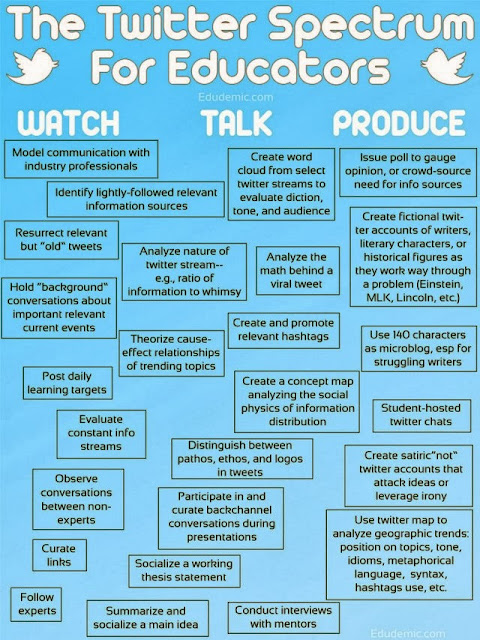In participating in a teacher twitter chat tonight, I think that I have established a pretty good idea of how twitter can be used to connect teachers and help to form professional connections. However, I have never had a very clear understanding of how to use twitter in the classroom and I think that I now have a better concept of precisely how to implement it.
When I was researching the topic of classroom applications of twitter, one source that I found quite helpful was Educational Technology and Mobile Learning's "A Must Have Guide on Using Twitter in Your Classroom". This article is excellent in that it gives a lot of different and specific applications for twitter in the average classroom. I always thought it would be used solely as a blog for students to react to given topics or to ask a teacher questions outside of the classroom if super motivated, but this article proved that there are many more practical applications of twitter to be explored. This guide to educational tweeting brought up an excellent point of connectivity: twitter can be used to post updates for parents and students about specific dates or information and it can be used to remind students what they learned that day or what the homework is. A teacher twitter can be a digital bulletin board that is dated and easy to track.
In addition, a teacher twitter can be a source of extra credit for students. Students can be given topics to participate in like pop quizzes or summaries where they are expected to produce a response to a provided prompt or they can participate in link-sharing where they bring information that they found on their own to the attention of teachers and classmates. The best part about a classroom twitter is that if a classroom hashtag is agreed upon, all students can track the class interaction and if a teacher re-tweets valuable contributions, students can get a running stream of what they should know.
I like that twitter, in the examples provided, gives students to show what they know, to interact with other students, to interact with their teacher, and to share found information with all. It creates a very multi-directional conversation which I think is very important in the language classroom.
Another article that I very much enjoyed is "Twitter HOTS & Establishing a Twitter Routine in the Classroom" by the Langwitches Blog. I really enjoyed this article because it organizes the information beautifully in many different diagrams that are well-organized and practical.
The above chart, for example, is excellent in that it shows how students can get more and more involved in classroom tweeting with a spectrum that ranges from receptive to productive skills. Furthermore, this article presents the value of twitter in its ability to help establish routine in the classroom and I think that routine is one of the most essential parts of a smoothly-running classroom. This article aligns twitter use with Bloom's Taxonomy, cites an example of a classroom routine with twitter, and gives many examples of practical applications. In other words, it's gold.
My readings for tonight have helped me to realize that the applications of twitter in the language classroom are limitless. There are many ways that I can use microblogging to connect with my students and parents and to help my students connect with each other and the world and because connectivity is such an important part of learning, knowing how to make it happen is essential!


I hope that you are able to try out a few of these suggestions and that they prove useful.
ReplyDelete